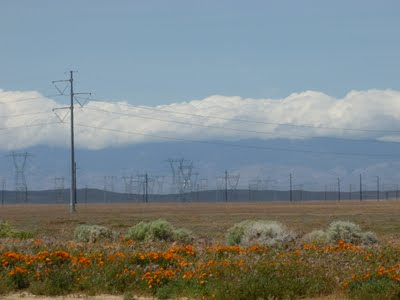Raw Materials: Hidden Carbon Costs of Utility-Scale Renewable Energy
No energy source is without its impacts, but considering how much steel and concrete is needed to construct utility-scale solar and wind facilities, we may be adding more greenhouse gas emissions than necessary. When most people in the United States think about clean energy, they picture facilities that are inherently not green -- solar facilities in the desert or gigantic wind turbines on hillsides tethered to our cities by hundreds of miles of costly transmission lines. These industrial facilities require amounts of materials and construction processes that make them unsustainable choices to replace dirty coal. When it comes to clean energy, nothing beats the efficiency and "green" of distributed energy, such as solar panels on rooftops or over parking lots, which require less of the materials that require carbon emissions to produce and transport.
Take a look at BrightSource Energy's Ivanpah Solar Electric Generating System in the northeastern Mojave Desert, over 140 miles from any major city in California. After bulldozing 5.6 square miles of pristine desert, the company now has to drill thousands of steel poles into the ground to mount mirrors that will reflect light on three central power towers. Each tower will be built with tons of concrete and steel. In order to get that electricity to customers in California's cities, the utility companies are building new transmission lines, requiring more steel and concrete.
In the video above, BrightSource Energy uses a "brush hog"to mow down several square miles of vegetation -- some of the shrubs are hundreds of years old -- to make way for thousands of steel poles and mirrors at its Ivanpah project site.
The Environmental Protection Agency calculated that the production of a ton of cement produces .97 tons of CO2 emissions. Depending on the source, steel manufacturing can result in 2.8 tons to .6 tons of CO2 per ton of steel produced. The US Geological Survey estimated that meeting 20% of our energy needs with wind energy would require 6.8 million tons of concrete, in addition to 1.8 million tons of steel, and 40,000 tons of copper. The American Wind Energy Association reported that in 2009 alone, wind energy construction consumed 1.7 million cubic yards of concrete (enough for more than 7,630 miles of 4-foot wide sidewalk). These raw materials are transported to the remote areas on large diesel guzzling trucks, and workers also commute long distances to reach the project sites each day.
SF6) is used by utility companies to insulate components and lines. SF6 is a potent greenhouse gas that has global warming potential 22,800 times greater than carbon dioxide.
All of these materials and transmission requirements not only make utility-scale energy more expensive to the ratepayers, it is most harmful to the environment. This is why our clean energy future should be focused on distributed generation, where we use spaces already available to us in our cities -- rooftops, parking lots, and brownfields -- where solar panels can be installed with minimal steel, concrete, copper, vehicle trips, and harmful transmission lines.
Take a look at BrightSource Energy's Ivanpah Solar Electric Generating System in the northeastern Mojave Desert, over 140 miles from any major city in California. After bulldozing 5.6 square miles of pristine desert, the company now has to drill thousands of steel poles into the ground to mount mirrors that will reflect light on three central power towers. Each tower will be built with tons of concrete and steel. In order to get that electricity to customers in California's cities, the utility companies are building new transmission lines, requiring more steel and concrete.
In the video above, BrightSource Energy uses a "brush hog"to mow down several square miles of vegetation -- some of the shrubs are hundreds of years old -- to make way for thousands of steel poles and mirrors at its Ivanpah project site.
The Environmental Protection Agency calculated that the production of a ton of cement produces .97 tons of CO2 emissions. Depending on the source, steel manufacturing can result in 2.8 tons to .6 tons of CO2 per ton of steel produced. The US Geological Survey estimated that meeting 20% of our energy needs with wind energy would require 6.8 million tons of concrete, in addition to 1.8 million tons of steel, and 40,000 tons of copper. The American Wind Energy Association reported that in 2009 alone, wind energy construction consumed 1.7 million cubic yards of concrete (enough for more than 7,630 miles of 4-foot wide sidewalk). These raw materials are transported to the remote areas on large diesel guzzling trucks, and workers also commute long distances to reach the project sites each day.
 |
| A photo from California Energy Commission showing early stages of construction for one of three giant steel and concrete towers for BrightSource Energy's Ivanpah Solar Electric Generating System. |
 |
| A mix of pole and lattice tower transmission lines stretch across the Antelope Valley in the western Mojave Desert, some of them newly built to bring wind energy to Los Angeles. |




Comments
Post a Comment